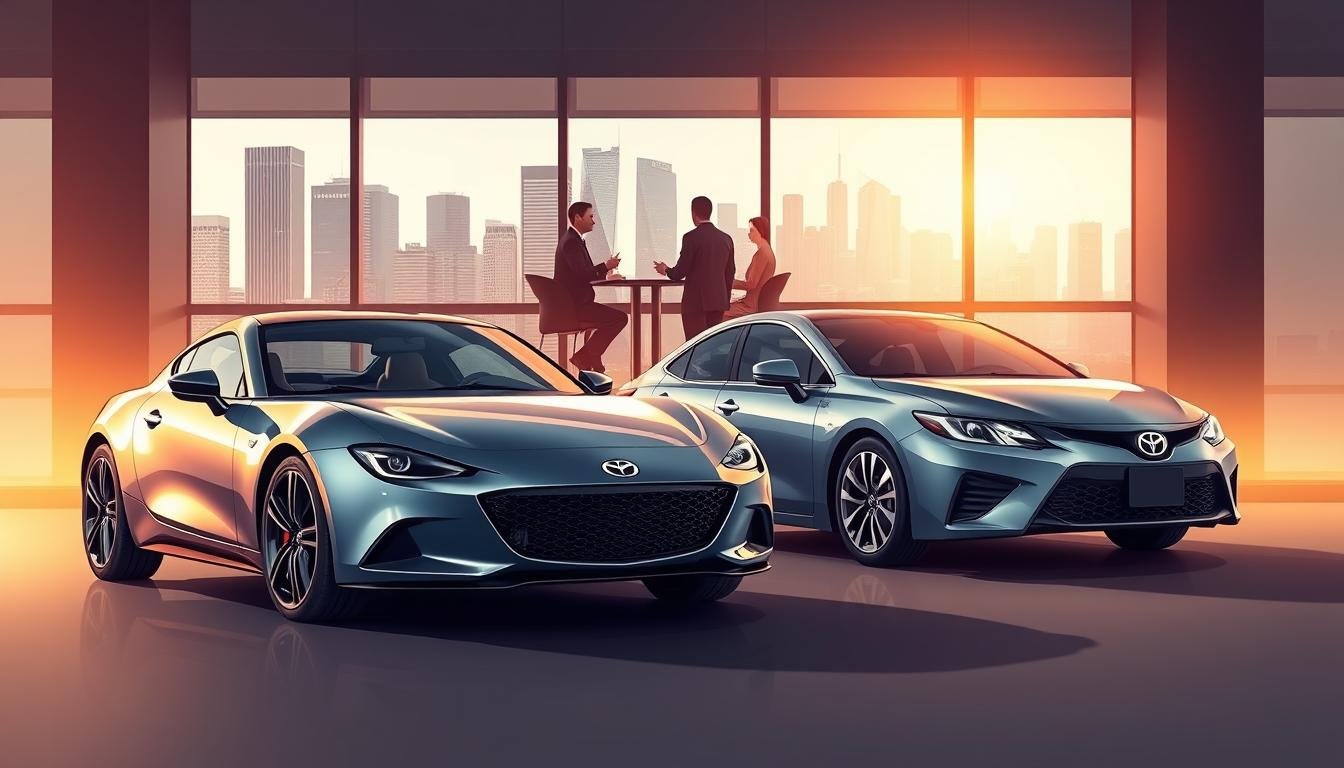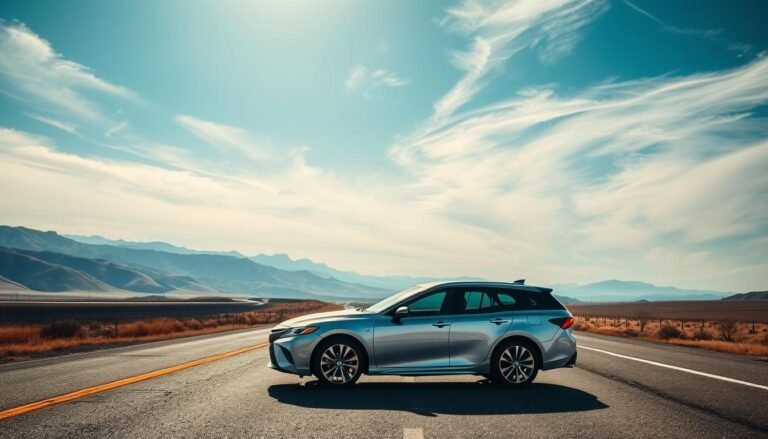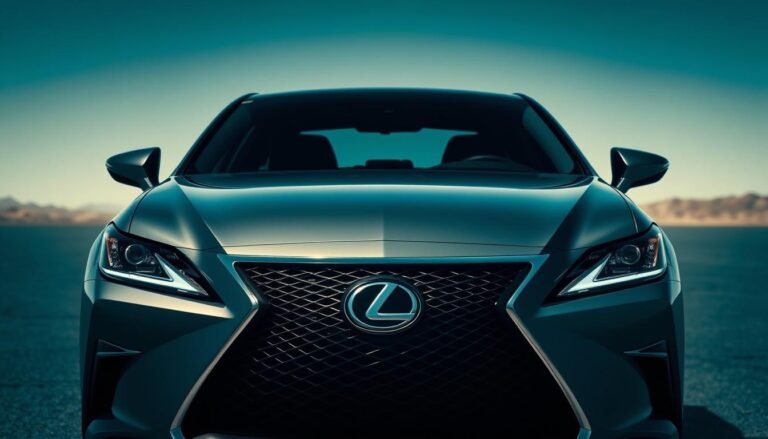Is Mazda Owned by Toyota? Ownership Facts
Many wonder, is Mazda owned by Toyota? The answer is no. Mazda stands on its own, with a special way of operating.
Mazda Motor Corporation is mostly in the hands of its shareholders, with about 92.86% of its shares freely traded.
This setup shows Mazda is not controlled by Toyota, despite what some might think. Mazda competes well in the market while keeping its independence from Toyota.
About 5.053% of Mazda is owned by Toyota, which is worth roughly 291 million yen ($1.98 million).
Besides Toyota, Mazda’s stakes are held by various big investors and key people within the company.
This ownership structure highlights Mazda’s freedom and the broad range of interests among its investors which fuel its success.
Next, we’ll explore Mazda’s rich history in the car industry, its growth over time, and key collaborations, including its work with Toyota.
You’ll get to understand why Mazda’s position in the car world is so special.
What is Mazda’s Automotive History
Mazda started its journey in 1920 as Toyo Cork Kogyo Co., Ltd. in Hiroshima, Japan. Switching from making cork to cars was a big leap.
The big change happened in 1931 when they made the Mazda-Go auto rickshaw. This was the start of Mazda’s long future in making cars.
Mazda is known for being creative and able to change. It became famous for its work on the rotary engine. The Mazda RX-7 and RX-8 showed off this unique engine.
It was smaller and lighter than regular engines. Mazda and Ford Motor Company were partners for a long time, from 1979 to 2015.
Ford owned about 33% of Mazda’s shares. This helped Mazda grow and change. Recently, Mazda started working with Toyota. They even built a plant together in Huntsville, Alabama.
These days, Mazda makes most of its cars in Hiroshima and Hofu in Japan. The Salamanca plant in Mexico makes cars for the Americas. It focuses on the Mazda2 and Mazda3.
The Mazda CX-5 has become a top compact SUV. This shows Mazda’s focus on being innovative and performing well. Mazda is now working on making driving better with Skyactiv technology.
This aims to use less fuel and cut down on emissions but keep cars fun to drive. Mazda is also working on hybrids and electric cars. This will help shape Mazda’s future in the car world.
Overview of Mazda Motor Corporation
Mazda Motor Corporation started on January 30, 1920. It stands out for its dedication to innovation. Its headquarters is in Fuchū, Japan.
n FY 2023, Mazda made 1.135 million vehicles. This shows their strong ability to make cars. This year, Mazda made ¥3.8 trillion and got ¥142 billion in operating income.
Their net income was ¥143 billion. They have assets worth about ¥3.26 trillion. This puts Mazda in a strong spot in the car market. Mazda has 48,750 people working for it as of 2022.
Their teamwork makes production and management smooth. They joined hands with Toyota, creating Mazda Toyota Manufacturing, U.S.A., Inc.
This partnership started on March 1, 2018. Their factory in Huntsville, Alabama can make 300,000 vehicles a year. Mazda keeps coming up with new ideas.
They made the SkyActiv platform and the MX-30. The MX-30 is Mazda’s first electric car, launched in 2020. Mazda focuses on making driving better and greener.
| Year | Production Output | Revenue (¥) | Operating Income (¥) | Net Income (¥) |
|---|---|---|---|---|
| 2023 | 1.135 million vehicles | 3.8 trillion | 142 billion | 143 billion |
| 2022 | N/A | N/A | N/A | N/A |
| 2021 | N/A | N/A | N/A | N/A |
Mazda has a long history of success and innovation. It keeps pushing forward, making cars better for the future.
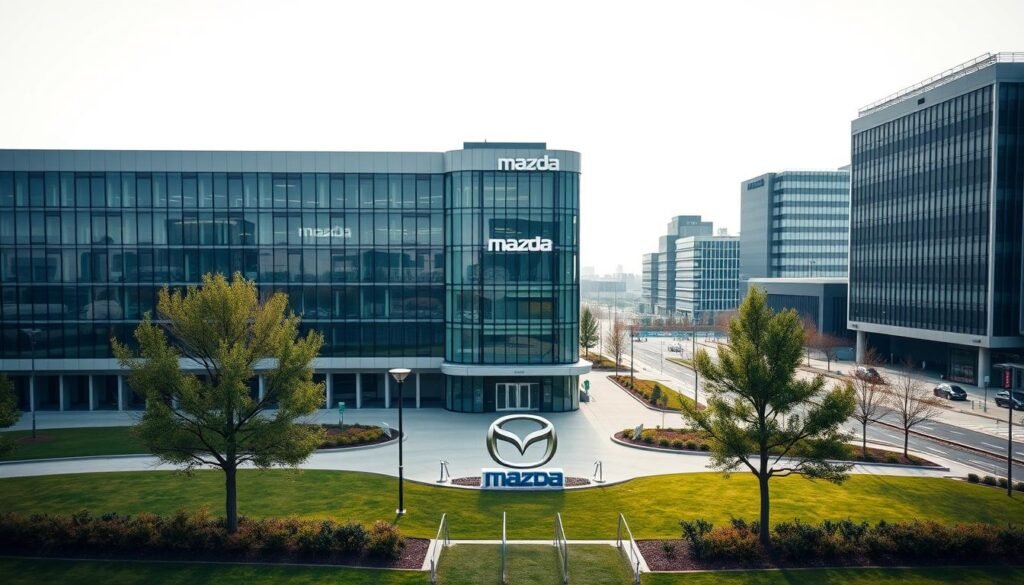
Formation and Evolution of Mazda
Mazda’s story began on January 30, 1920, as Toyo Cork Kogyo, a cork product maker. It entered the car industry in 1931 with its first vehicle.
The 1960s brought Mazda’s breakthrough with the Wankel engine, setting it apart in the car world.
The partnership between Mazda and Ford started in 1979, with Ford eventually owning 33.4% by 1995. But by 2015, Ford sold its Mazda shares, allowing Mazda to grow on its own.
In 2017, Mazda and Toyota teamed up to make electric vehicles. Announced on August 4, this move showed Mazda’s shift towards green technology. They plan to produce up to 300,000 vehicles yearly at a new US factory.
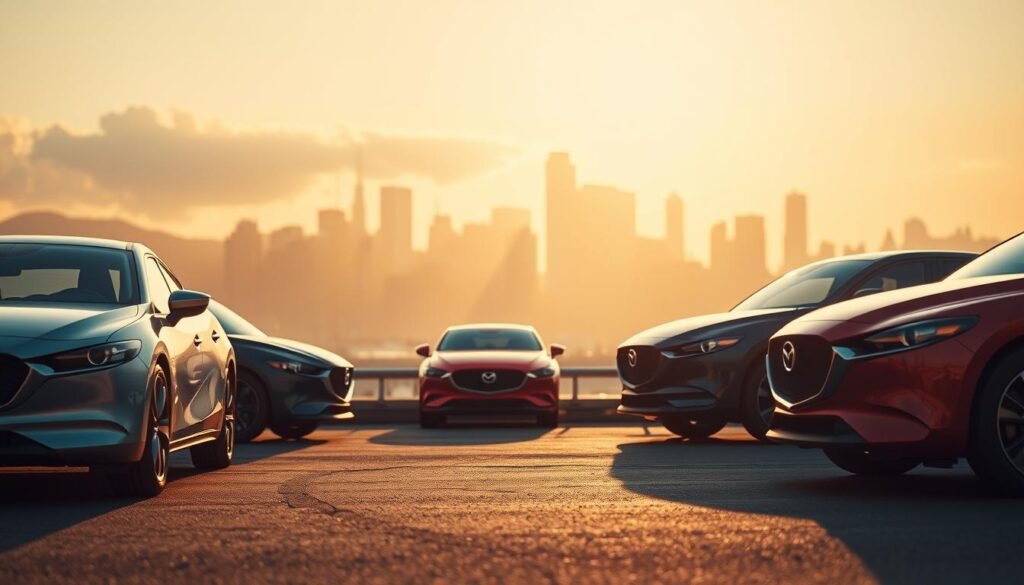
For 2023, Mazda made 1.135 million vehicles and earned ¥3.8 trillion. This financial success reflects Mazda’s ability to stay ahead through innovation.
Mazda remains a key figure in the global car market, continually evolving and innovating.
Notable Partnerships in Mazda’s History
Mazda has teamed up with big names, and these partnerships have been key to its growth. The partnership with Ford, from 1974 to 2015, is a highlight.
It helped Mazda use Ford’s resources and tech to create popular cars. Mazda also worked with Nissan and Toyota, making better products together.
The Mazda-Toyota joint venture is a big step for car making. They are building a $1.6 billion plant, which will create 4,000 jobs and make 300,000 vehicles a year.
These partnerships help Mazda tackle big challenges, like making cleaner engines and cheaper electric vehicles. The SKYACTIV-Z engine and EV savings show how teamwork leads to innovation.
Looking ahead, Mazda keeps focusing on working with others. This strategy helps it stay competitive and adapt to changes in the car world.
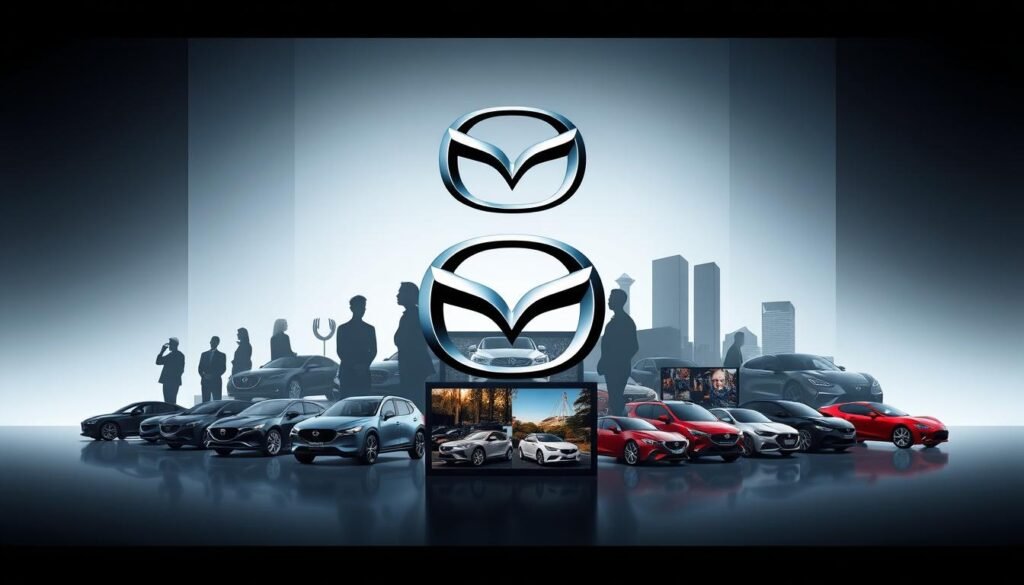
Is Mazda Owned by Toyota?
The mazda ownership structure helps us understand the company’s independence and how it connects with other car giants.
Toyota owns about 5.1% of Mazda, which is a large but not controlling share. This means Mazda makes its own decisions, and it’s not just a part of Toyota.
Current Ownership Structure of Mazda
Mazda Motor Corporation is mostly owned by itself, with 67.5% of its shares. This self-ownership lets it make important decisions on its own. Other investors and people owning shares complete the remaining 32.5%.
Here’s a closer look at who owns what:
| Stakeholder | Percentage of Shares | Value (approx.) |
|---|---|---|
| Master Trust Bank of Japan, Ltd. | 17.1% | $710 million |
| Custody Bank of Japan, Ltd. | 5.4% | $225 million |
| JPMorgan Securities Japan Co., Ltd. | 2.4% | $99 million |
| Toyota Motor Corporation | 5.1% | Not disclosed |
Shareholder Information and Stakeholders
Looking into mazda shareholders shows us the company’s financial strength and the trust investors have in it. Big Japanese banks play a major role, showing strong support for Mazda.
This boosts the mazda stock information profile. Mazda’s revenue hit $33.31 billion by the end of March 2024, marking a promising uptick in its financial performance.
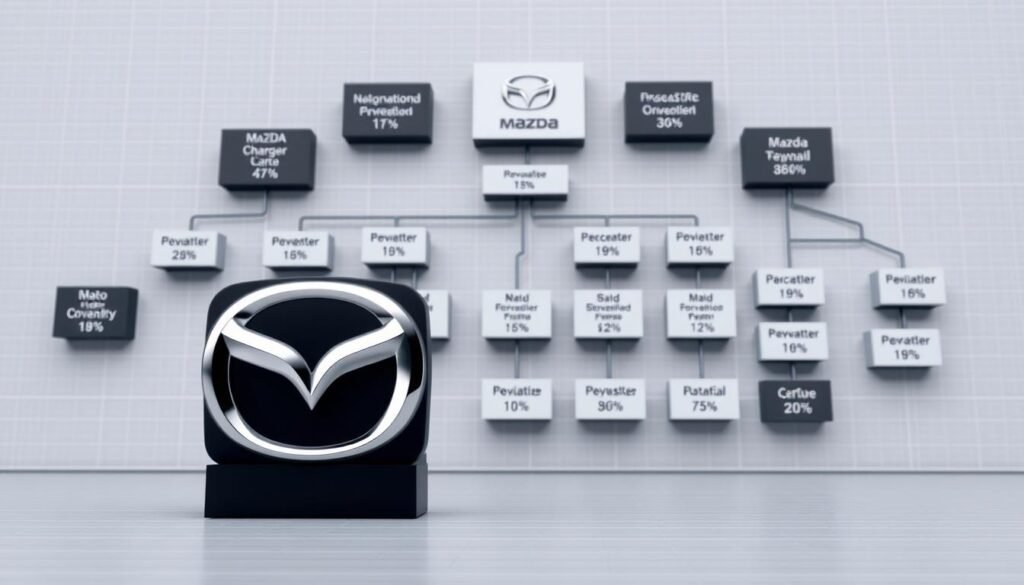
Exploring The Mazda-Toyota Relationship
The Mazda and Toyota partnership has grown strong. They started working together to make their operations better while keeping their brand’s uniqueness.
In 2018, they opened Mazda Toyota Manufacturing U.S.A. (MTM) in Huntsville, Alabama. This big move, costing $2.3 billion, was to meet market demands.
The MTM plant can make 300,000 vehicles a year and created 4,000 jobs. It began making the Mazda CX-50 and Toyota Corolla Cross in 2022.
By sharing resources and tech, both companies save money and spark innovation. Toyota owns 5.1% of Mazda, which is about 31.9 million shares.
Mazda has most of its shares (92.86%) available for the public. In 2023, Toyota made over 8.6 million vehicles and Mazda made 1.135 million.
Mazda’s earnings were ¥3.8 trillion with a ¥143 billion profit. This shows how two competing companies can work together for better results.
They share tech and collaborate closely. As cars and their tech change, so will the Mazda and Toyota partnership. They aim to keep improving and staying ahead in the market.
Overview of The Mazda and Toyota Partnership
The partnership between Mazda and Toyota is a big deal in the car industry. They joined forces in 2017 to make better cars by combining their strengths.
This summary explores their teamwork and the projects they’ve started together.
History of Collaboration between Mazda and Toyota
Mazda and Toyota started working together on August 4, 2017. They made a deal to work on new technologies and expand their skills.
One big achievement is opening Mazda Toyota Manufacturing, U.S.A., Inc. (MTMUS) in Huntsville, Alabama. It started in 2020 and began making cars in 2021.
MTMUS can make 300,000 cars a year. They split this number between Mazda’s crossover and the Toyota Corolla. This project, costing $1.6 billion, created about 4,000 jobs.
It’s a big help for Mazda, which used to depend a lot on cars from Japan. The partnership is also working on electric cars, online car features, and safety tech to keep up with strict rules and competition.
Mazda and Toyota each own half of this venture. This teamwork has led to more efficient production. It also shows a strong focus on being eco-friendly and innovative.
| Aspect | Details |
|---|---|
| Joint-Venture Company | Mazda Toyota Manufacturing, U.S.A., Inc. |
| Annual Production Capacity | 300,000 units |
| Investment for Facility | $1.6 billion |
| Employment Potential | Up to 4,000 jobs |
| Production Capacity Breakdown | 150,000 units for Mazda’s crossover model, 150,000 units for Toyota Corolla |
| Date of Establishment | March 1, 2018 |
| Start of Production | 2021 |
The Mazda-Toyota Joint Venture Explained
The Mazda Toyota joint venture started on March 1, 2018. It formed Mazda Toyota Manufacturing U.S.A., Inc. (MTMUS).
This partnership aims to boost both companies’ production abilities. The new facility in Huntsville, Alabama, started in 2021.
Both Mazda and Toyota invested $1.6 billion together, splitting the cost evenly. They aim to build 300,000 vehicles a year together.
This effort expected to create 4,000 jobs, showing its positive effect on the local economy. The partnership kicked off with the Toyota Corolla Cross in September 2021.
Then came the Mazda CX-50 in January 2022. Each model is built on its own line, Apollo for Corolla Cross and Discovery for CX-50. This shows their focus on quality.
This facility helps both brands stay flexible in the changing car market. It shows that working together is key to meeting market needs. This may lead to more partnerships in the future.
Recent Developments in The Mazda-Toyota Partnership
The Mazda-Toyota partnership is making great strides in innovation and cooperation. They’re focusing on making cars that are better for the planet.
Together with Subaru, they’re creating new engine tech that works well with electric parts like batteries and motors.
This means cars can be made smaller, which helps them cut through the air better. These forward-thinking engines will work with eco-friendly fuels.
This reflects a big change towards more sustainable cars. The three companies know how important it is to cut down on pollution.
Their efforts could lead to cars with sleeker designs and better gas mileage. Mazda plans to roll out seven to eight new electric cars by 2030.
These new models could make up to 25-40% of its worldwide sales. One example is the CX-50 Hybrid, powered by Toyota’s tech.
It gets 38 MPG and can tow up to 1,500 lbs. Starting at $33,970, it’s expected to do well in the market. The Mazda Toyota Manufacturing plant in Huntsville, Alabama, is key to these plans.
Before, Mazda cars had to be shipped from Japan. Now, this plant will make popular cars like the Corolla Cross and the CX-50. This move will make delivering these cars faster and more efficient.
Leaders from both companies are working hard to make their operations more green. They’ve set high goals for making cars that don’t harm the environment.
Toyota wants to make about 10.3 million vehicles by 2024. Mazda’s work with Toyota could cut the cost of creating new software by up to 80%. This partnership looks promising for both companies’ futures.
| Aspect | Details |
|---|---|
| Joint Ventures | Collaboration includes production at Mazda Toyota Manufacturing USA. |
| New Models | 7-8 new EV models from Mazda by 2030. |
| Fuel Efficiency | CX-50 Hybrid achieves 38 MPG; 10 MPG better than non-turbo variant. |
| Production Targets | Toyota aims for approximately 10.3 million vehicles worldwide in 2024. |
| Cost Reduction | Potential 70%-80% reduction in development costs through collaboration. |
| Focus Areas | Decarbonization, engine efficiency, and achieving carbon neutrality. |
Conclusion
Mazda stands as its own force in the car world. Even though Toyota owns about 5.1% of Mazda, which is roughly 31.9 million shares, this doesn’t mean Toyota controls Mazda.
This partnership mainly shows their joint efforts to lead in innovation and being strong competitors in the auto sector. Mazda’s ownership mix is well-balanced.
About 92.86% of Mazda’s shares are publicly traded, with institutional investors owning around 45.83% of these.
This mixture ensures Mazda’s independence, allowing it to run on its own while still gaining from collaborations in manufacturing and tech advancements.
Thinking about Mazda’s relationship with Toyota shows how both benefit each other. Mazda focuses on quality cars and Toyota on innovation.
This makes the car market richer for all of us. Knowing how these companies work together helps us see the auto industry’s changing face.
FAQs
Is Mazda owned by Toyota?
No, Mazda isn’t totally owned by Toyota. Toyota has about 5.1% of Mazda’s shares. This lets Mazda work on its own.
What is the relationship between Mazda and Toyota?
Mazda and Toyota work together to make better cars and technology. But, they each keep their own style and brand.
What historical milestones marked Mazda’s evolution?
Mazda’s big moments include changing from Toyo Cork Kogyo Co., Ltd. to a car maker in the 1930s. They also created the Mazda-Go auto rickshaw and worked on rotary engines.
What are some notable partnerships in Mazda’s history?
Mazda teamed up with Ford from 1974 to 2015. Recently, it’s been working with Toyota and others to make better cars.
What does Mazda’s current ownership structure look like?
Big players in Mazda’s ownership include the Master Trust Bank and Custody Bank of Japan. Toyota has a smaller share.
Can you explain the Mazda-Toyota joint venture?
Mazda and Toyota joined to create Mazda Toyota Manufacturing U.S.A. in Alabama. They focus on building cars like the Toyota Corolla Cross and Mazda CX-50.
What recent developments have occurred in the Mazda-Toyota partnership?
They’ve recently made the Huntsville plant bigger. They’re also teaming up on electric vehicle projects, showing their partnership is growing.

